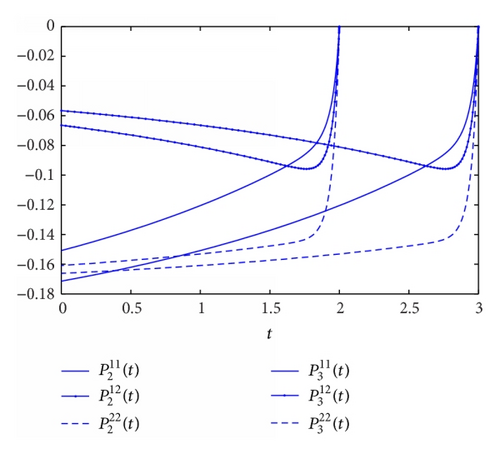Study on Index of Stochastic Linear Continuous-Time Systems
Abstract
This paper studies the index problem. We obtain a necessary and sufficient condition of index larger than γ > 0. A generalized differential equation is introduced and it is proved that its solvability and the feasibility of the index are equivalent. We extend the deterministic cases to the stochastic models. Our results can be used to fault detection filter analysis. Finally, the effectiveness of the proposed results is illustrated by an example.
1. Introduction
It is well known that many control and filtering problems have been discussed based on a certain performance index of a system, such as norm, norm, and index; see [1–9]. norm is the measure of the worst-case disturbance inputs on the controlled outputs [1–4]. The index is a measure of the minimum sensitivity of system outputs to system inputs. norm and index with specific application to fault detection filter have been carried out in [10–17]. To ensure robustness, index should be maximized and norm should be minimized. Using performance can make certain that the residual signal is maximally sensitive to faults and highly robust to disturbance inputs; see [16, 17].
In [12], index was defined as the minimum nonzero singular value in zero frequency. In [10], the authors extended the results of [12] to all frequency range. By means of LMIs, a necessary and sufficient condition was given for the infinite frequency range. The case for finite frequency range was concluded through frequency weighting. In recent decades, a great deal of attention has been attracted to index in time domain. A fault residual generator was designed to maximize the fault sensitivity in the finite time domain [16–20]. Based on index, results on optimal fault detection can be found in [17, 18] and the references. The lower bound of index for linear time-varying systems was proposed in [19, 20]. A sliding mode observer was designed for sensor fault diagnosis of nonlinear time-delay systems; see [21]. In [22], a fault-tolerant controller was projected to compensate nonlinear faults by using a fuzzy adaptive fault observer.
Although there is much work on the index problem, to the best of our knowledge, very little work was concerned with the index in stochastic systems. In this paper, the index for stochastic linear continuous-time systems is discussed. The definition of the index is extended to the stochastic case. We present a necessary and sufficient condition of the index. A generalized differential equation is introduced and it is proved that its solvability and the feasibility of the index are equivalent. Comparing our results with the bounded real lemma [2, 9], it shows that the index is not completely dual to norm. The index discussed in this paper is only for tall or square systems. The reason for this is that index is zero for wide systems. But bounded real lemma for is applicable to any systems. Finally, the effectiveness of the given methods is illustrated by numerical example.
The outline of the paper is organized as follows. In Section 2, some efficient criteria are given for the index of stochastic linear systems in finite horizon. Section 3 contains an example provided to show the efficiency of the proposed results. Finally, we conclude this paper in Section 4.
Notations. R is the field of real numbers. Rm×n is the vector space of all m × n matrices with entries in R. is the set of all real symmetric matrices Rn×n. A′ is the transpose of matrix A. A−1 is the inverse of A. Given positive semidefinite (positive definite) matrix A, we denote it by A ≥ 0 (A > 0). E is the mathematical expectation. I is identity matrix. 0n is n × n zero matrix. is the space of nonanticipative stochastic process y(t) ∈ Rp with respect to increasing σ-algebras (t ≥ 0) satisfying , where . A square (wide or tall) system denotes a system when the number of inputs equals (is more than or less than) the outputs number.
2. Finite Horizon Stochastic Index
In this section, we will discuss the index problem of stochastic linear continuous-time systems. We give a necessary and sufficient condition of the index larger than γ > 0 in finite horizon.
The finite horizon stochastic index of system (1) can be stated as follows.
Definition 1. For stochastic system (1), given 0 < T < ∞, its index in [0, T] is defined as
Remark 2. If v is fault signal and z is the residual, then the index describes the smallest fault sensitivity of system (1). In this paper, we suppose that system (1) is tall or square because the index is zero for wide system.
Remark 3. It can be shown that is equivalent to the following inequality
Remark 4. When T = ∞, (2) corresponds to the infinite horizon case.
Lemma 5. Suppose is continuously differentiable, T > 0. Then, for every x0 ∈ Rn, ,
Proof. Let x0 ∈ Rn, , and x(t) = x(t; v, x0) denote the corresponding solution of (1). Applying Ito’s formula to x(t)′P(t)x(t) and taking expectations, we have that, for any T > 0,
Below, we prove the following theorem which is necessary in this paper.
Theorem 6. For (1) and some given γ > 0, if the following differential Riccati equation
Proof. By Lemma 5, for every , v ≠ 0, x0 = 0, we conclude that
From Hγ(PT(t)) > 0, , to show , we define the operator : with its realization:
Then exists, which is determined by
We assume that Hγ(PT(t)) ≥ ϵI, ϵ > 0, so there exists constant C0 > 0, such that
Now, we consider the following equation:
It is easy to see that (17) satisfies the following equation:
Lemma 7. Suppose F(t) ∈ C[0, T] and is the solution of (18). Then if , one obtains
Proof. In terms of Lemma 5 with and F(t)xF(t) + v(t) for v(t),
Now we are in a position to prove that is invertible for t ∈ [0, T].
Lemma 8. For system (1), if for some given γ > 0, F(t) ∈ C[0, T], T > 0, and satisfies (18). Then,
Proof. Let us first prove that . Suppose this is false; then there exists t∗ ∈ [0, T), u ∈ Rl, ‖u‖ = 1 such that for some η > 0. Then, for sufficiently small δ > 0,
Next, let for any ρ > 0 and λ = (γ2 + ρ2) 1/2. Replacing γ with λ in (18), we obtain the corresponding solution . Applying the previous step, we can deduce that . For any t0 ∈ [0, T), set , t ∈ [0, T − t0]. Let be the solution of (18) with γ replaced by λ and F replaced by on [0, T − t0]. Then, , t ∈ [0, T − t0]. By (22), for any t0 ∈ [0, T), x0 ∈ Rn,
Remark 10. By the equality A(I − BA) −1 = (I − AB) −1A, we have that C′[I − D(D′D − γ2I) −1D′]C = C′(I − γ−2DD′) −1C. If system (1) is time-invariant and square, by (29),
Now, we present the following theorem which is important in this paper.
Theorem 11. Suppose system (1) is time-invariant and square and satisfies for given γ ≤ 0. Then (11) has a unique solution PT(t) ≤ 0 on [0, T] for every T > 0. Moreover, is minimized by the feedback control:
Proof. We prove that implies the existence of solution PT(t) of (11) on [0, T]. Using a contradiction argument, we suppose that (11) does not admit a solution. By the standard theory of differential equations, there exists unique solution PT(t) backward in time on maximal interval [T0, T] (T0 ≥ 0), and as t → T0, PT(t) becomes unbounded.
Let 0 < δ < T − T0, , , , by completing the squares; then
Furthermore, we can see that
Take ,
Setting F(t) = FT(t), t ∈ [0, T], in (17), from (31), we obtain
According to Theorems 6 and 11, we get the following theorem.
Theorem 12. If system (1) is time-invariant and square, for given γ > 0, the following are equivalent:
- (i)
Consider .
- (ii)
The following equation
(56)
Remark 13. For given γ > 0, if we replace B, C, D, and v(t) with , , , and , respectively, and z(t) with zδ(t) in (1), we deduce the corresponding index and
Now, we are to show what happens as T increases.
Theorem 14. If system (1) is time-invariant and square, for some γ > 0. Then PT(t) in (56) decreases as T increases for every t ∈ [0, T].
Proof. Suppose , t ∈ [0, T], and x0 ∈ Rn. Let be optimal for x0 on [0, T − t], and set
3. A Numerical Example
Below, we give a numerical example to illustrate the rightness of Theorems 12 and 14.
Example 1. In system (1), we consider a two-dimensional linear stochastic system with the following parameters:

4. Conclusion
In this paper, we have solved the index problem where both stochastic and deterministic perturbations are present. Necessary and sufficient condition for the lower bound of index is given by means of the solvability of a generalized differential equation. The proposed results are not completely dual to norm, and the effectiveness of the given methods is illustrated by numerical example.
Conflict of Interests
The authors declare that there is no conflict of interests regarding the publication of this paper.
Acknowledgments
This work is supported by National Natural Science Foundation of China (Grants nos. 61174078, 61170054, and 61402265) and the Research Fund for the Taishan Scholar Project of Shandong Province of China.




